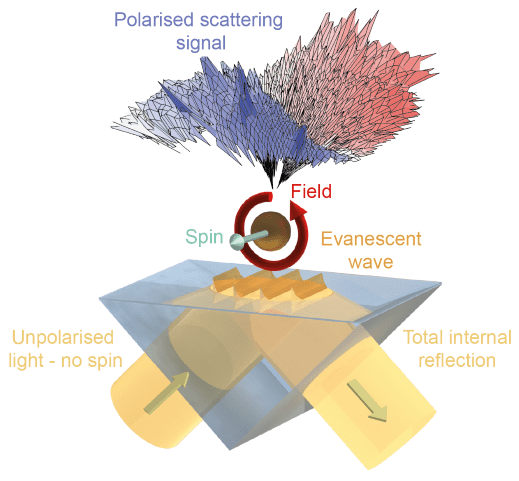A beam transformed: Optical transforms like tight focussing and total internal reflection, which gives rise to an evanescent field, can lead to out-of-plane polarization components and transverse spin, even for totally unpolarized input light. (Courtesy: Konstantin Bliokh/Diane Roth)”>
It’s been almost a century since Wolfgang Pauli mooted the idea of “hidden rotation”: a new quantum variable that would double the number of possible electron states. Today, this variable is known as spin angular momentum, and it’s widely accepted as an intrinsic property of fundamental particles. Yet despite the ubiquity of spin, there is still no real consensus about its physical meaning.
For photons, the usual explanation is that spin is related to circular polarization – a state of affairs in which the direction of the electromagnetic field in a beam of light rotates in a plane perpendicular to the direction of propagation, like hands round a clock face. This explanation has a straightforward consequence: no polarization, no spin. Now, however, an international collaboration of researchers has cast doubt on this principle by measuring non-zero transverse spin values in totally unpolarized light. In ruling out this supposedly fundamental requirement, the new observations expand our understanding of what spin angular momentum is not, while raising further questions about what it is.
The discovery of transverse spin
Physicists’ understanding of spin has evolved over the past 10 years thanks to the proposal (and later experimental corroboration) of transverse spin – that is, spin on an axis perpendicular to the direction of light propagation. In general, once you get far enough from a light source (or if you use a beam like a laser), light rays propagate essentially parallel to each other (paraxial rays), such that the light beam’s polarization is strictly confined to the plane perpendicular to the direction of propagation. For light that is circularly polarized in that plane, this picture implies that any resulting spin must align either longitudinally along the direction of propagation or directly against it. However, that did not always stack up with what researchers – including some at King’s College London in the UK – were observing. “We saw some interesting phenomena in electromagnetism that were hard to explain,” recalls Francisco Rodríguez-Fortuño, a researcher at King’s who was involved in the latest developments.
In 2013, when Rodríguez-Fortuño and his colleagues were working on circularly polarized dipoles (mimicked using an illuminated slit in gold film) next to waveguides. They took their “interesting phenomena” to Konstantin Bliokh, a researcher at RIKEN in Japan. Bliokh had been developing a theory that suggested that a light beam could acquire an out-of-plane polarization component if it underwent certain transformations, such as total internal reflection to produce a non-propagating “evanescent field” that fades exponentially from surfaces, or tight focussing. The conclusion of this theoretical work was that if these non-propagating forms of light had a longitudinal polarization component, they could have transverse spin. “Then everything made sense,” Rodriguez-Fortuño tells Physics World.
Beyond 2D polarization
By this point, observations of transverse spin were racking up for beams that initially had all kinds of polarizations and were then focused or reflected. These results implied that the polarization of the initial beam didn’t actually affect the transverse spin measurements. Meanwhile, further theoretical predictions remained untested – including one that suggested that transverse spin should appear even without any polarization in the initial beam.
The reasoning here is that, in effect, once the electric field’s longitudinal component is taken into consideration, the light field ceases to be a 2D phenomenon, and must instead be described in 3D. From that perspective, even a beam of light that is completely unpolarized in 2D has a non-zero level of polarization in 3D, simply because it has no longitudinal components. With that in mind, Bliokh posed a question for King’s researchers led by Anatoly Zayats: could they demonstrate this effect experimentally?
The answer, eventually, was “yes”. Although Diane Roth, a postdoctoral researcher at King’s, says the experiment was “not the hardest”, it did have some unexpected challenges. “One difficulty was to find a source of truly unpolarized light that also produced enough intensity for the effect to be measured,” says Roth, who worked on experiments measuring spin from an evanescent field. Since all laser light is polarized, the King’s researchers had to look elsewhere for their source. In the end, they found themselves working with a “humble incandescent light bulb” instead.

Photons with half-integer angular momentum are the latest twist on light
Meanwhile, collaborators at the Max Planck Institute for the Science of Light and University Erlangen-Nuremburg in Germany, and the University of Graz in Austria took a different tack. In their experiments on tightly focused light, they varied the polarization from a laser and then averaged measurements taken over long periods of time to get an effectively unpolarized light source. Despite their different source of unpolarized light, and differences in the transformations used to produce light fields with an out-of-plane electric field component, these groups also found that measurements from a scattering nanoparticle gave non-zero transverse spin quantities.
The researchers say that the biggest impact of their results will be a contribution to our understanding of what spin angular momentum is. However, that is not to say it will be without applications. Luke Nicholls, who was involved in the research at King’s, notes that it could have advantages for switching and routing light in photonic circuits. “In principle it could make this sort of routing cheaper and easier to do in the long run because you don’t necessarily have to have a fancy laser or things like that,” he says. “You can just do it with a bulb or an LED.”
The researchers describe their work in Nature Photonics.
